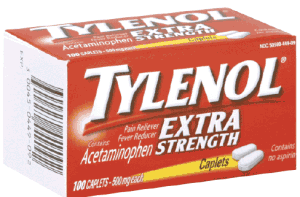 Tylenol is the brand name of this North American brand of medications.
Tylenol is the brand name of this North American brand of medications.
Acetaminophen is the name that will be on the medication when looking at the box or at the insert packaging. Tylenol or Acetaminophen are used interchangeably. They are pain medications and they work quite well.
In the rest of the world, Acetaminophen is more commonly known as Paracetamol. The chemical structure of Acetaminophen is the following compound – N-acetyl-para-aminophenol (APAP) A portion of this name is broken down – end of the second word tyl and the end of fourth word enol. These are combined to form Tyl-enol.
Tylenol is indicated for the treatment of pain but it is also can be used to reduce fever, and to help with symptoms of allergies, cough, congestion, colds, and the flu. It is often used in the combination of other medications.
Tylenol has gone through a tough history, especially with rising concerns about overdoses. Back in 1982, seven people died from Tylenol poisoning. It was later determined that some Extra Strength Tylenol had been deliberately contaminated with Cyanide. This was not done in by the manufacture, but by an individual. The medication was pulled and it took a few years to get the medication back on the shelf. Increased security, discontinuation of capsules, and tamper-proof seals on outside lid of containers were some of the steps taken.
Again in 2010 another recall was done to several hundred batches of bottles as complaints were made about the smell that emanated from the bottle. A musty smell could be detected. The findings illustrated that a chemical used in the packaging of the bottles could be the cause. It appears that changes were made on the packaging chemicals.
The real risk however with Tylenol is Overdose.
As with many other medications, there is a ceiling point, or maximum dosing instructions on Tylenol. This means that you should not go over a certain amount of medications per day. In this instance, speaking about Acetaminophen, that maximum dosing is 4 grams. Often single tables come in 325mg, 500mg, and occasionally 1000mg. 1000mg equals 1 gram.
The problem occurs in many different ways, but often someone takes Tylenol daily. But on top of that, they take another medication where Tylenol is a combination drug such as Lortab, Excedrin, Midol, NyQuil, Vicodin, Percocet, and many more.
Every drug is broken down in the body. Some are eliminated through the liver, kidney, or other. Tylenol greatly affects the liver. Other medications can also cause organ damage, but Tylenol is three times more likely to cause liver failure than all other drugs combined. As a drug is broken down, it is done so into what is called metabolites. It is a metabolite of Tylenol that can be dangerous.
Tylenol can also be more deadly when the patient is drinking alcohol or if the liver has already been affected by another cause.
The first twenty-four hours are often symptom free and maybe up to forty eight hours. The sooner the treatment the better.
Symptoms from Tylenol overdose are long and ranging. Common symptoms may be Nausea, sickness, fatigue, malaise, abdominal pain, and others. When symptoms are present, it is important or someone has concern that a Tylenol overdose is possible. Seek immediate evaluation. Charcol is a good treatment to prevent absorption of Tylenol and should be administered by a health care professional. Blood work checking for Tylenol levels is necessary as well.
It is important to make one thing certain: Tylenol when take correctly is a very good medication. This goes along with a ton of other medications. Excess use of Tylenol is what is concerning. As patients taking Tylenol, we must all be more conscience of the medications we take and often check to see of Acetaminophen is one of the medications being used in what we are taking. This warning does not mean that we should stop taking Tylenol. A healthy understanding is necessary.


